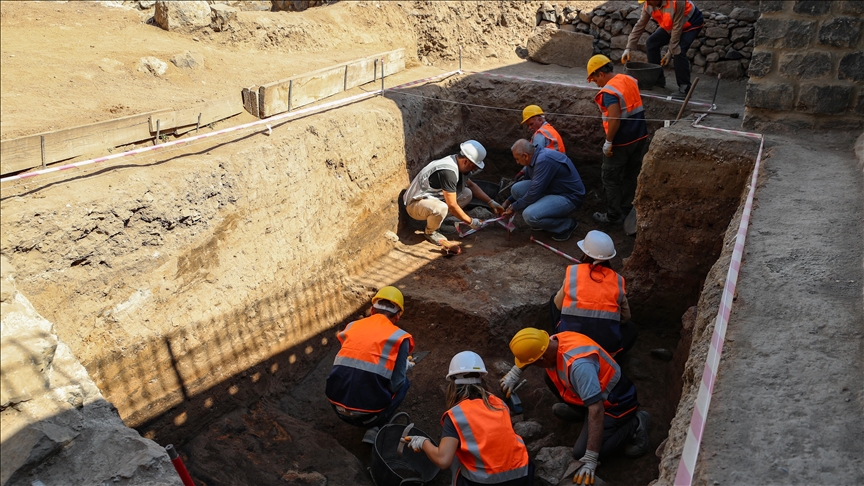ISTANBUL
Excavations at Amida Mound, referred to as the “heart of Diyarbakir,” have uncovered evidence that settlement at this archaeological site dates back 10,000 years.

The mound has served as a settlement for numerous civilizations, including the Hurri-Mitanians, Urartians, Assyrians, Medes, Persians, Tigran the Great Kingdom, Romans, Sassanids, Byzantines, Umayyads, Abbasids, Marwanids, Seljuks, Artuqids, Ayyubids, Aq Qoyunluids, Safavids, and Ottomans. Excavations at the site began in 2018 under the direction of Professor Irfan Yildiz from Dicle University’s Faculty of Education, with the approval of the Turkish Ministry of Culture and Tourism.
Among the discoveries made so far are remnants such as 1,800-year-old water channels, a heating system, 1,700-year-old burial chambers, 782 World War I grenades, and 800-year-old marble artifacts. Current work focuses on the area south of the reception hall of the Artuklu Palace and between Saraykapi and the King’s Road.
Based on evidence from fire traces, ceramic fragments, and stone materials found in one trench, researchers determined that settlement began 10,000 years ago at the mound.
‘Amida was set ablaze along with its contents, and the fire continued for several days.’
Yildiz explained that they initiated the excavation in a trench located in the damaged section of Saraykapi and the King’s Road. He explained,
“During the excavations in this trench, 3 burn marks, which were previously found in the trenches at the bottom of the mound, appeared here. Necessary examinations and dating were made with the Carbon-14 method. The first burnt layer of the city was 6,764 BC, the second burnt layer was 5,721 BC, and the third burnt layer was 5,518 BC.
Therefore, the city was burnt 3 times between 7 thousand and 5 thousand BC. Especially in this trench, the traces of the 6,764 BC burn layer were much more intense. There are burn marks ranging between approximately 5-10 centimeters. We understand from this that Amida, which was an important city at that time, was burned together with its inhabitants and the fire lasted for days.”

Yildiz also noted that civilizations inhabiting Amida Mound made construction advancements based on previous settlements. They found obsidian tools dating back to 8,000 BC just beneath the fire layer from 7,000 BC.
He emphasized that continuous life has persisted at Amida Mound for 10,000 years, as indicated by the 8,000 BC ceramic shards and stone artifacts discovered in the same trench.
‘The excavation is poised to alter the historical narrative of Diyarbakir’
“When we started the excavations at Amida Mound, we initially estimated its history to begin around 3,500 BC, approximately 5,500 years ago. However, this date is continually being updated based on new findings. In the trench where we are currently working, we found evidence dating back to 10,000 years,” Yildiz stated, adding that this date might change as excavations progress.
“It is certain that there will be data dating back to 9 thousand BC, which is 11 thousand years from today, and maybe we will go even further. When we look at life in the region, we see that settlement started around 10,500 BC in Kortik Tepe, Hasankeyf Mound and Gobeklitepe, and goes up to 12,500 BC.
Amida Mound will probably be dated close to these dates. For the time being, we can say that a settlement started here 10 thousand years ago and continued uninterruptedly. This is the most important feature of Amida Mound. As it can be understood from the excavations, settlement has never been interrupted in any period.”
Yildiz observed that Jericho in Palestine is recognized as the earliest city on Earth where life has persisted continuously, with evidence indicating that settlement in Jericho began 11,000 years ago.
“Amida Mound is in second place, settlement started here 9 thousand years ago. However, as of now, it has shifted to 10 thousand years ago. We can now say that for Amida Mound, settlement started 10 thousand years ago and continued uninterruptedly, the data clearly shows this. After the work in the trench is completed, I think we can say that settlement started here 11 thousand years ago. The excavation of Amida Mound will continue to be a candidate to change the history of Diyarbakir.”

